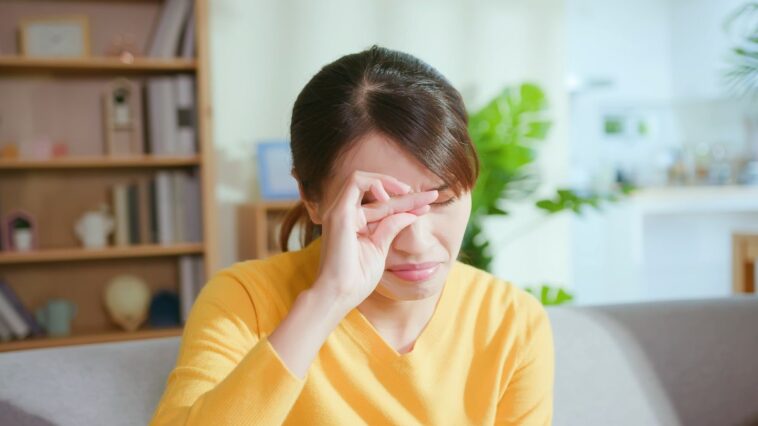Chronic dry eye syndrome, also known as Dry Eye Disease (DED), is a common condition in which a person’s eyes do not produce enough or poor-quality tears. This can lead to burning, itching, redness, and eye discomfort. In severe cases, chronic dry eye can cause damage to the surface of the eyes and affect vision.
What Causes Chronic Dry Eye?
Several factors can contribute to the development of chronic dry eye syndrome, including:
- Age: Chronic dry eye is a condition that may more commonly affect people as they age because their tear production levels tend to decline. This can lead to uncomfortable symptoms, such as redness and irritation of the eyes.
- Hormonal changes: Chronic dry eye can be caused by hormonal changes, such as those that occur during menopause. Menopause reduces tear production and can lead to long-term dryness of the eyes.
- Medical conditions: Chronic dry eye occurs when an underlying medical condition affects tear production. Common conditions that cause chronic dry eye include rheumatoid arthritis, Sjogren’s syndrome, and other autoimmune diseases.
- Medications: Chronic dry eye can be caused by several medications, including antihistamines, antidepressants, and birth control pills. These types of medication reduce tear production, which can lead to long-term symptoms of chronic dry eye.
- Environmental factors: Prolonged screen use, exposure to wind or dry environments, and working in air-conditioned or heated environments can cause chronic dry eye by reducing tear production and evaporation.
- LASIK surgery: LASIK surgery has been known to cause chronic dry eye due to its interference with the nerve pathways that trigger tear production. Those who have had LASIK surgery are more likely to experience and suffer from this condition.
- Blepharitis: Blepharitis is a significant cause of chronic dry eye, in which the eyes are not adequately lubricated. This condition occurs due to eyelid inflammation, which disrupts tears’ creation and dispersal.
It’s important to note that many people have more than one risk factor for chronic dry eye and that the severity of symptoms can vary from person to person.
What Are The Symptoms of Chronic Dry Eye?
The symptoms of chronic dry eye can vary, but the most common symptoms include the following:
- Eye dryness: A feeling of dryness, grittiness, or scratchiness in the eyes.
- Eye discomfort: A burning or stinging sensation in the eyes.
- Eye redness: Redness of the eyes caused by inflammation of the eye’s surface.
- Light sensitivity: Increased sensitivity to light, known as photophobia.
- Blurred or hazy vision, particularly in dry or windy conditions.
- Eye fatigue: Tiring of the eyes, especially after prolonged screen use.
- Mucus in or around the eyes: The production of stringy mucus in or around the eyes, caused by a response to the irritation caused by dryness.
- Eye irritation: An overall feeling of irritation or discomfort in the eyes.
How Is Chronic Dry Eye Diagnosed?
Chronic dry eye syndrome diagnosis typically involves a comprehensive eye exam and a discussion of your symptoms and medical history. Your eye specialist may use one or more of the following tests to diagnose chronic dry eye:
- Tear film break-up time (TBUT) test: This test measures the time it takes for the tear film to break up after a blink, indicating the stability of the tear film.
- Schirmer test: This test measures the amount of tears produced by the eyes over a set time.
- Lissamine green staining test: This test involves using a yellow dye applied to the eye’s surface to detect any areas of damage or inflammation.
- Meibomian gland imaging: This test uses a specialized device to capture images of the meibomian glands, which produce the oily component of tears.
- Inflammatory marker tests: Your eye doctor may perform tests to measure levels of inflammatory markers in your tears, such as matrix metalloproteinases (MMPs), interleukin-1 (IL-1), and tumor necrosis factor-alpha (TNF-alpha).
Based on the results of these tests, your eye doctor can diagnose chronic dry eye and recommend the appropriate treatment. In some cases, additional tests may be necessary to rule out other causes of dry eye symptoms.
Treatments For Chronic Dry Eye
Chronic dry eye syndrome treatment depends on the severity of symptoms and the underlying cause. Some common treatments include:
- Artificial tears: the use of artificial tears help moisturize the eyes and provide relief from associated symptoms. These artificial tears are available without a prescription and can be available over the counter for convenient purchases.
- Warm compresses: Applying warm compresses to the eyelids can help to unblock the meibomian glands and improve the quality of tears.
- Omega-3 supplements: Omega-3 fatty acids can help to reduce inflammation and improve the quality of tears.
- Punctal plugs: Punctal plugs can be inserted into the tear ducts to reduce tear evaporation and improve tear volume.
- Eyelid hygiene: Keeping the eyelids clean and debris-free can help prevent inflammation and promote healthy tear production.
- Prescription eye drops: In severe cases of chronic dry eye, prescription eye drops may be necessary to reduce inflammation and improve tear production.
- Lifestyle modifications: Making simple lifestyle modifications, such as using a humidifier, avoiding wind and dry environments, and reducing screen time, can help to reduce dry eye symptoms.
In some cases, a combination of treatments may be necessary to achieve optimal relief from chronic dry eye symptoms. Your eye doctor can help you determine the best treatment for your needs.
Natural Remedies for Treating Chronic Dry Eye
In addition to the treatments mentioned above, several natural remedies can be used to help relieve chronic dry eye symptoms:
- Reduce screen time: Reducing the amount of time spent in front of screens, such as computers and televisions, can help to reduce eye fatigue and dryness.
- Fish oil: Fish oil supplements, which are high in omega-3 fatty acids, can help to reduce inflammation and improve the quality of tears.
- Blink frequently: Blinking regularly throughout the day can help distribute tears evenly over the eye’s surface and reduce dryness.
- Hydrate: Staying hydrated by drinking plenty of water can help maintain the eyes’ overall health and reduce dry eye symptoms.
- Humidify: Using a humidifier in your home or workplace can help to add moisture to the air and reduce dry eye symptoms.
- Herbs: Certain herbs, such as chamomile and green tea, contain anti-inflammatory compounds that may help to reduce dry eye symptoms.
It’s important to note that while these natural remedies may help to relieve dry eye symptoms, they should not be used as a substitute for medical treatment. If you are experiencing chronic dry eye symptoms, it’s essential to consult an eye doctor, who can diagnose the cause of your symptoms and recommend the appropriate treatment.
When to See a Doctor for Chronic Dry Eye Treatment
You should see an eye doctor if you are experiencing chronic dry eye symptoms, such as persistent dryness, burning, or itching, or if you have trouble wearing contact lenses or experiencing blurred vision. An eye doctor can diagnose the cause of your symptoms and recommend the appropriate treatment.
In some cases, chronic dry eye can be a symptom of an underlying medical condition, such as Sjogren’s syndrome, autoimmune disease, or a hormonal disorder, so it’s essential to seek medical attention. Early treatment of chronic dry eye can help to prevent long-term damage to the eyes and preserve vision.
If you are experiencing severe symptoms, such as redness, swelling, or sensitivity to light, or if you have a sudden vision change, you should seek immediate medical attention, as these symptoms may indicate a more serious eye condition. Your eye doctor can perform a comprehensive eye exam and determine the best treatment for your needs.
Conclusion
Chronic dry eye is a common condition that affects millions of people and can cause significant discomfort and vision problems.
It is essential to seek medical attention if you are experiencing chronic dry eye symptoms, as early treatment can help prevent long-term damage to the eyes and preserve vision.
Several treatments are available, including artificial tears, warm compresses, omega-3 supplements, punctal plugs, prescription eye drops, lifestyle modifications, and natural remedies such as warm compresses, fish oil, and hydration.
Your eye doctor can determine the best treatment for your individual needs and help you find relief from chronic dry eye symptoms.






